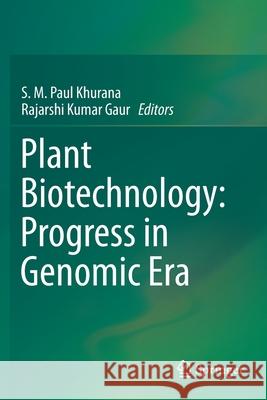Plant Biotechnology: Progress in Genomic Era » książka



Plant Biotechnology: Progress in Genomic Era
ISBN-13: 9789811385018 / Angielski / Miękka / 2020 / 670 str.
Plant Biotechnology: Progress in Genomic Era
ISBN-13: 9789811385018 / Angielski / Miękka / 2020 / 670 str.
(netto: 1073,48 VAT: 5%)
Najniższa cena z 30 dni: 1079,53
ok. 22 dni roboczych
Dostawa w 2026 r.
Darmowa dostawa!
Selected Innovative Solutions for the Regulation of GM crops in times of Gene Editing
Prof. (Dr.) S.M. Paul Khurana had PhD in 1969 on papaya viruses, and 2 years of Post-Doctoral Research (1970-72) in Adv Plant Virology at Kyushu University, Fukuoka, Japan with Prof Zyun Hidaka as JSPS fellow. Also availed GOI DBT overseas fellowship for one year at University of Minnesota, St Paul (USA) with Prof EE Banttari & specialized in Immunodiagnostics (March 1987 to April, 1988). Worked at Central Potato Research Institute(CPRI), Shimla since 1973 as Scientist/Sr Scientist ,Principal Scientist, Head, Virus/Seed Pathology (1976-82/1988), Principal Scientist & Head, Plant Pathology Divn (1988-93), Project Coordinator AICRP-Potato( 1994-2004), and Director (2002-2004)CPRI, Shimla; Vice -Chancellor, Rani Durgavati University, Jabalpur (2004-2009).Also served as visiting Consultant for CIP/FAO (1992, 1996,1997). Then as the Director, Amity Instt of Biotechnology, AUUP, Noida (2009-10),and moved to Amity Univ Haryana at Gurgaon in Aug 2010 for establishing Instt of Biotechnology (2010-2015), Dean, Sci, Engg & Technology (2013-contd.) Amity Univ Haryana, Gurgaon. An internationally recognized Plant Virologist/Pathologist & Biotechnologist having 53yrs experience, 230 research papers & 100+ reviews, guided 16 PhDs, edited 16 books etc.
Dr. Rajarshi Kumar Gaur earned PhD in 2005, now Professor & Head, Department of Bioscience, Mody University of Science and Technology, Lakshmangarh, Sikar, Rajasthan, India. His Ph.D was on molecular characterization of sugarcane viruses, viz., mosaic, streak mosaic and yellow luteovirus. He received MASHAV fellowship in 2004 of Israel government for his post-doctoral studies and joined The Volcani Centre, Israel and BenGurion University, Negev, Israel. In 2007 he received the Visiting Scientist Fellowship from Swedish Institute Fellowship, Sweden for one year to work in the Umeå University, Umeå, Sweden. He has made significant contributions on sugarcane viruses and published 130 national/international papers and presented near about 50 papers in the national and international conferences. He was awarded as Fellow of Linnean Society, London. Currently, he is handling many national & international grants and international collaborative projects on plant viruses and disease management.Refinement in sequencing technologies and potential of genomic research resulted in meteoric growth of biological information such as sequences of DNA, RNA and protein requiring databases for efficient storage, management and retrieval of the biological information. Also, computational algorithms for analysis of these colossal data became a vital aspect of biological sciences. The work aims to show the process of turning bioscience innovation into companies and products, covering the basic science, the translation of science into technology. Due to rapid developments, there seems to be no basic difference between the pharmaceutical industry and the biotechnological industry. However, approved products in the pipeline and renewed public confidence make it one of the most promising areas of economic growth in the near future. India offers a huge market for the products as well as cheap manufacturing base for export. The book is a sincere work of compilation of new and recent advances in the topic of concern through various innovative researches and scientific opinion therefrom. The book is dedicated to the readers who will definitely find it interesting and knowledgeable in carrying out their respective researches in different aspects of applied microbiology and biotechnology.
1997-2025 DolnySlask.com Agencja Internetowa
KrainaKsiazek.PL - Księgarnia Internetowa









